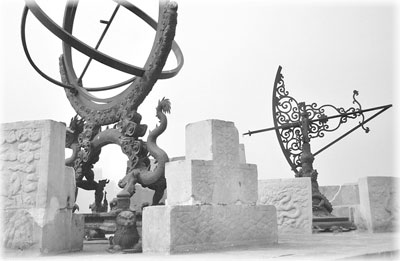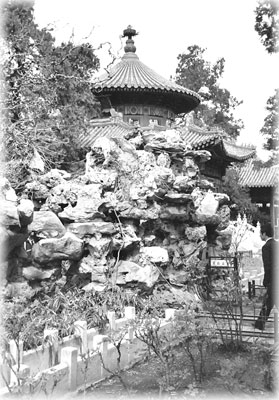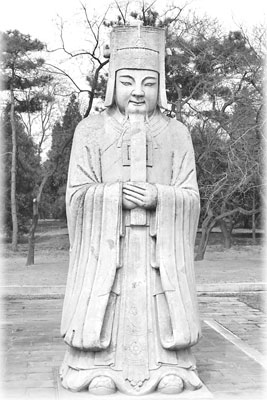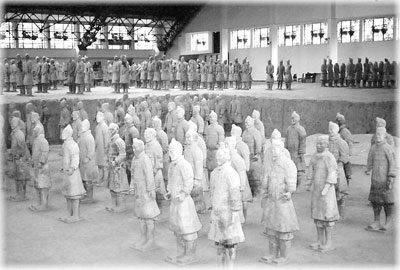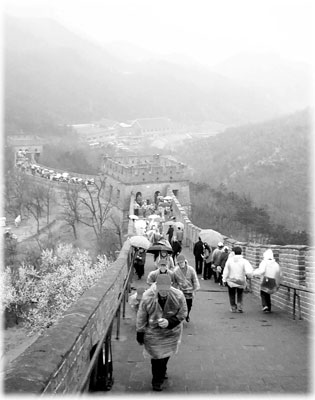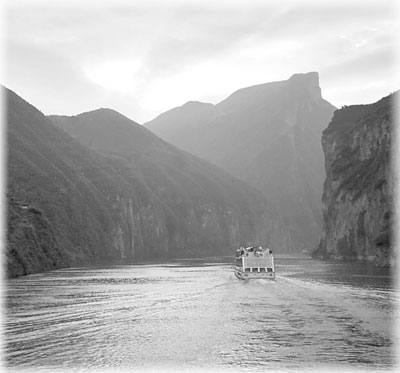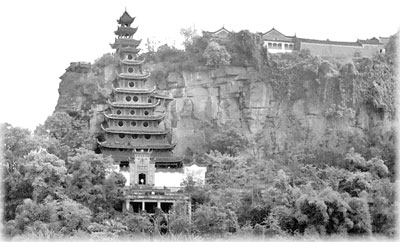Impressed with an introduction to China
by Mary Beltran, Associate Editor
As our introduction to China, my husband, Cesar, and I toured the highlights of its imperial past and took a short cruise on the Yangtze. In April ’05 we participated in the 10-day “Imperial Jewels of China” cruise-tour, starting in Beijing, as a guest of Viking River Cruises (Woodland Hills, CA; phone 877/668-4546).
Since we wanted to explore our own interests in Beijing as well, we contacted Mrs. Ping Lee of ChinaPlus, Inc. (Las Colinas, TX; phone 888/868-8811 or 972/887-9088 or visit www.chinaplustour.com) to set up a pre-cruise visit.
Ping arranged three days tailored to our wishes, including accommodations, a guide and a car with driver to take us to some of the sights that weren’t included on Viking’s group tour.
Beijing stay
We stayed at the Chang’An Grand Hotel, now called Days Inn Hotel & Suites (27 Hua Wei Li, Chao Yang District; phone 011 86 10 67731234), a clean, modern and comfortable hotel.
There was an excellent seafood restaurant downstairs in addition to the Regal Palace Theatre Restaurant, where they have a dinner and stage show production every night. Our room was excellent, with a good view of Beijing.
The hotel is located slightly away from the city center, which was good for us because we avoided some of the heavy traffic.
Our guide met us promptly at the airport and we had two days packed with sightseeing. I really enjoyed the Ancient Observatory, where beautifully crafted and decorated scientific instruments used to measure time, set calendars and study stars were on display. This old stone observatory building is now dwarfed by the highrises that surround it. It was a quiet place and seemed nearly forgotten by tour operators.
The Big Bell Museum was another delight — filled with ornate carved brass and iron temple bells. Many were covered with Buddhist text and commemorated special events. The bells were huge, most measuring five to six feet tall, with some even larger.
Groups of schoolchildren were being brought through, but very few Western visitors were there. Our guide was surprised we had chosen this museum and said he hadn’t been there in years.
We wandered the hutongs looking for gifts, then had the privilege of visiting the workshop of a shadow puppet theater troupe. We spoke with Master Lu, a sixth-generation puppeteer who had started his training as a child. A group of teenagers in training were busy practicing the intricate puppet walking movements behind a big white screen.
Light was projected from behind the screen, creating colored shadows of the puppets as they moved — it looked magical.
Traditionally, the plays go on for hours, but today’s audiences don’t care for the lengthy performances, so few troupes survive. Master Lu’s group was revising the traditional stories as well as developing new ones to appeal to contemporary audiences.
We also visited the Temple of Heaven with its huge garden complex surrounding the main temple buildings. The gardens and long pavilions are used by locals to socialize, play chess and make music. The temple itself was very impressive but a little worn.
The next day we drove out to see the Sacred Way and the Ming Tombs. The Sacred Way, a long processional walk which leads to the tomb area, is lined with huge, elaborately carved stone beasts and representations of court nobles. We had a beautiful sunny morning for this, but it would be difficult to do the long walk in the heat of summer.
The exhibits at the Ming Tombs were breathtaking. Gold, jewels and other burial items from one of the many tombs were displayed in a museum on site.
We also visited the Beijing Zoo, where our guide was surprised that Cesar wanted to see more than just the pandas. (Evidently, most tourists are interested only in the pandas and don’t bother with the rest.) It was a rather grim, old-fashioned zoo with concrete cages for most of the animals. However, the bird exhibits and habitats were quite nice.
Our guide and driver were very pleasant and helpful. They were always on time and went out of their way to help us see our chosen sights, which were a little off the beaten path. We thoroughly enjoyed the arrangements made by China Plus.
More Beijing sights
After our first three days in Beijing, we met up with the Viking River Cruises cruise-tour group. We stayed at the Beijing Hotel in the heart of the tourist area of Beijing, just a few blocks from Tiananmen Square and the Forbidden City.
Viking was extremely well organized and managed the unwieldy group of over 300 guests by dividing us into subgroups. We chose excursions to the Forbidden City and Tiananmen Square for our first day and the Great Wall of China for the second.
Although I had seen it many times on TV and in the movies, I was surprised at the huge open space of Tiananmen Square. It was bustling with people — some tourists and soldiers but primarily Chinese nationals. There were the usual long lines at Mao’s tomb, but we didn’t have hours to wait.
The Forbidden City was also enormous in size and intimidating in its architecture (by design). The design reflects the formal structure of the empire as well as the fears of the various emperors (isolation was a means to prevent assassination attempts). It seemed a very gloomy and eerily depressing place.
We walked from large courtyard to large courtyard for hours. It was a lot of walking and stepping up and down small staircases.
Modern tourism has made its impact. There is a Starbucks in the corner of one of the courtyard buildings (Arrgh!), and areas and buildings were under repair in preparation for the upcoming Summer Olympics.
On our visit to the Great Wall of China, we found the restored Badaling Hills section to be very touristy, and yet the reality of the place was impressive. We drove out of Beijing and up into the mountains on a gray, cold and misty day. Unprepared visitors were purchasing blue trashbag-like rain ponchos and shivering as they walked along the top of the wall. It was really difficult clambering up the steep slope on wet, slick rocks.
All around me, people were holding up their cell phones to take pictures and shouting into them — in multiple languages — versions of, “Yeah, can you believe it? I’m calling you from the Great Wall of China!” I had to laugh.
What stands out in my mind about Beijing is the contrast of the enormous, lively, changing, modern city marked by gridlock, building cranes and construction with the mammoth, static historic sites of ancient stone and thousand-year-old buildings. How gray and stony everything was! There was not a lot of color in clothes or buildings.
Xi’an
We flew to Xi’an the next day. As we drove through the countryside, we passed huge agricultural areas with farms and orchards followed by large cities with construction cranes. (I counted 14 in one glance around me in Xi’an.) There was so much building and change, but the people I met seemed very enthused (if a little nervous) about catching up with the Western world.
That evening we enjoyed a performance of the Tang Dynasty Show near our hotel, Hotel Shangri-la Golden Flower.
In the morning we visited the Terra Cotta Army Museum (Bingmayong). I grew up reading National Geographic and have pored over the pictures of the discoveries at Xi’an many times. It was just as amazing as I had hoped!
This is a huge museum complex with airplane hangar-sized buildings covering the dig sites. The lessons learned from the first dig have been applied at the others, but there are still problems to solve before final excavation (if funds are ever found to finish).
It was a very busy place with lots of visitors.
We had a great noodle lunch at an on-site restaurant, and I loved watching the flamboyant noodle makers whipping the dough around in the air.
Yangtze cruise
We flew to Chongqing to board the Viking Century Sky, our ship for the Yangtze River cruise portion of the tour. We were to travel on her inaugural cruise.
The Century Sky is a brand-new ship with lovely, spacious public areas. Two tiny passenger elevators assist those who have trouble with the stairs from the main lobby and dining level to passenger sleeping decks and topside. The English-speaking staff and crew were young, cheery and eager to please.
The cabins were very nice, with compact but comfortable accoutrements, and each had a balcony. The dining room was sunny, with panoramic views of the river, and the excellent galley was designed to serve gourmet Western and Eastern cuisine. The dining staff was still learning the finer points but was very helpful.
However, well-laid plans can often go awry in China. Hard rains upstream caused a rapid rise in the river level and the ship had to be moored farther out in the river. Viking had to rig up make-do gangplanks that zigzagged out to the ship. All the boarding passengers queued up to cross one at a time, and it took hours to load all of the 300 passengers and their luggage. This meant a late start to the grand dinner and inauguration party. It was not as Viking envisioned, but they coped well.
What I remember most of my cruise on the Yangtze River and through the Three Gorges and Lesser Three Gorges is the stunning scenery. Twisting my neck to see it all literally made my head ache. Although the water level has risen considerably since the building of the Three Gorges Dam, the sheer vertical climb of the cliffs and riverbanks still offers a lot of beauty to see.
The morning we were scheduled to enter one of the most scenic portions of the river trip, I got up at sunrise to go out on the upper deck to view it. It was cold but worth it.
However, in preparation for the rising water levels, changes were very apparent along the banks of the river. We saw abandoned villages and towns — gray buildings with black holes for windows and doors — which stood in contrast to the bright, white new towns built high above on the hillsides and hilltops.
Many of the ancient terraced farms that have been so fertile for years are now scheduled to be inundated and the farmers shifted to higher, less fertile terraces.
There are changes in village life all along the Yangtze as well. Our local guides said that it was good for the young people but very hard on elders.
In the Lesser Three Gorges we had lunch at a private restaurant run by Viking River Cruises for its passengers. The excellent barbecue lunch was served on china with glass goblets under awnings on the riverbank — quite deluxe.
We docked one morning for a visit to the Shibaozhai Pagoda. We disembarked at the floating dock and climbed through the tourist-trap market and up to the weathered wooden pagoda. Then it was climb, climb, climb, up to the very top — very hard on my knees and my nerves. After a pause for pictures it was down, down, down, then back through the gauntlet of “hello people” to the ship.
Our final stop on the river was the Three Gorges Dam. We had been scheduled to take the ship through the lock, but at the last minute (literally) we were told the lock was closed for maintenance. Viking worked around that by arranging buses and guides, and we were driven down to the dam, then on to the airport.
The dam tour is limited to visitors’ center displays and viewing from the park along the bank, as access to the dam is restricted for security reasons. Two-thirds of the construction was complete at the time of our visit, and the water level had been raised twice.
The design and planned regulation of the water level is quite controversial. Regulation of a riverine system on that scale has never been tried, and many are anxious about how it will work in reality once the dam is completed.
Shanghai
We flew on to Shanghai and drove from the airport through the city at night. Oh, the lights! The skyscrapers were lit up Vegas style along the exteriors. The guides were very proud of all of the cutting-edge architecture in the city, including 20 to 30 buildings of which any one would be considered a landmark in any city in the world.
Our final farewell dinner, a long gourmet Chinese feast, was at the Shanghai Westin. I made it through without too much embarrassment as I demonstrated the chopstick facility I gained during the trip. (I only chased a few peanuts around on my plate.)
In spite of the boarding issues and problems dealing with government officials, Viking River Cruises successfully coped and produced a very enjoyable tour on the first voyage of the Viking Century Sky.


